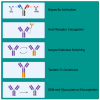Beyond bNAbs: Uses, Risks, and Opportunities for Therapeutic Application of Non-Neutralising Antibodies in Viral Infection
- PMID: 38651408
- PMCID: PMC11036282
- DOI: 10.3390/antib13020028
Beyond bNAbs: Uses, Risks, and Opportunities for Therapeutic Application of Non-Neutralising Antibodies in Viral Infection
Abstract
The vast majority of antibodies generated against a virus will be non-neutralising. However, this does not denote an absence of protective capacity. Yet, within the field, there is typically a large focus on antibodies capable of directly blocking infection (neutralising antibodies, NAbs) of either specific viral strains or multiple viral strains (broadly-neutralising antibodies, bNAbs). More recently, a focus on non-neutralising antibodies (nNAbs), or neutralisation-independent effects of NAbs, has emerged. These can have additive effects on protection or, in some cases, be a major correlate of protection. As their name suggests, nNAbs do not directly neutralise infection but instead, through their Fc domains, may mediate interaction with other immune effectors to induce clearance of viral particles or virally infected cells. nNAbs may also interrupt viral replication within infected cells. Developing technologies of antibody modification and functionalisation may lead to innovative biologics that harness the activities of nNAbs for antiviral prophylaxis and therapeutics. In this review, we discuss specific examples of nNAb actions in viral infections where they have known importance. We also discuss the potential detrimental effects of such responses. Finally, we explore new technologies for nNAb functionalisation to increase efficacy or introduce favourable characteristics for their therapeutic applications.
Keywords: Fc receptors; antibody engineering; antiviral immunity; immunoglobulin; neutralizing antibodies; viral infection.
Conflict of interest statement
The authors declare no conflicts of interest.
Figures



Similar articles
-
Lack of ADCC Breadth of Human Nonneutralizing Anti-HIV-1 Antibodies.J Virol. 2017 Mar 29;91(8):e02440-16. doi: 10.1128/JVI.02440-16. Print 2017 Apr 15. J Virol. 2017. PMID: 28122982 Free PMC article.
-
Broadly Neutralizing Antibodies Display Potential for Prevention of HIV-1 Infection of Mucosal Tissue Superior to That of Nonneutralizing Antibodies.J Virol. 2016 Dec 16;91(1):e01762-16. doi: 10.1128/JVI.01762-16. Print 2017 Jan 1. J Virol. 2016. PMID: 27795431 Free PMC article.
-
Polyreactivity and autoreactivity among HIV-1 antibodies.J Virol. 2015 Jan;89(1):784-98. doi: 10.1128/JVI.02378-14. Epub 2014 Oct 29. J Virol. 2015. PMID: 25355869 Free PMC article.
-
Recent Progress toward Engineering HIV-1-Specific Neutralizing Monoclonal Antibodies.Front Immunol. 2016 Sep 30;7:391. doi: 10.3389/fimmu.2016.00391. eCollection 2016. Front Immunol. 2016. PMID: 27746780 Free PMC article. Review.
-
Polyfunctionality of broadly neutralizing HIV-1 antibodies.Curr Opin HIV AIDS. 2023 Jul 1;18(4):178-183. doi: 10.1097/COH.0000000000000799. Epub 2023 May 9. Curr Opin HIV AIDS. 2023. PMID: 37249912 Review.
Cited by
-
Developing a Vaccine Against Human Cytomegalovirus: Identifying and Targeting HCMV's Immunological Achilles' Heel.Vaccines (Basel). 2025 Apr 22;13(5):435. doi: 10.3390/vaccines13050435. Vaccines (Basel). 2025. PMID: 40432047 Free PMC article. Review.
-
Deciphering Host-Virus Interactions and Advancing Therapeutics for Chronic Viral Infection.Viruses. 2025 Mar 10;17(3):390. doi: 10.3390/v17030390. Viruses. 2025. PMID: 40143318 Free PMC article. Review.
-
Discovery of a pan anti-SARS-CoV-2 monoclonal antibody with highly efficient infected cell killing capacity for novel immunotherapeutic approaches.Emerg Microbes Infect. 2025 Dec;14(1):2432345. doi: 10.1080/22221751.2024.2432345. Epub 2024 Dec 9. Emerg Microbes Infect. 2025. PMID: 39584380 Free PMC article.
References
-
- Suryadevara N., Shrihari S., Gilchuk P., VanBlargan L.A., Binshtein E., Zost S.J., Nargi R.S., Sutton R.E., Winkler E.S., Chen E.C., et al. Neutralizing and protective human monoclonal antibodies recognizing the N-terminal domain of the SARS-CoV-2 spike protein. Cell. 2021;184:2316–2331.e15. doi: 10.1016/j.cell.2021.03.029. - DOI - PMC - PubMed
Publication types
LinkOut - more resources
Full Text Sources
Research Materials

